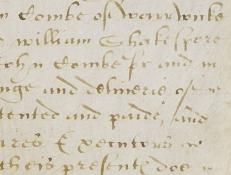To view a sortable list, please visit the Resource
All Documents
July 18, 1598
In the summer of 1598, Thomas Blackford of Butlers Marston sold a house on the north side of Sheep Street, Stratford-upon-Avon, to Daniel Smith. The deed recording the sale, shown here, was drawn up on July 18.
February 4, 1598
In this 1598 survey of those storing grain in Stratford-upon-Avon, “W[illia]m Shackesp[ear]e” is listed as holding 10 quarters of malt.
ca. 1600
SHAKESPEARE DOCUMENTED IS STILL GROWING! Descriptive content and transcriptions will continue to be added, updated and expanded. Check back for regular updates!
September 8, 1601
John Shakespeare was buried on September 8, 1601, according to the Holy Trinity Church parish register. Next to the entry, an “X” added by a later hand highlights its significance.
May 1, 1602
In 1602 William Shakespeare negotiated with John Combe for the purchase of 107 acres for £320, a considerable sum. Two copies were made of the deed conveying this land.
May 31, 1602
Richard Quiney was buried on May 31, 1602, as recorded in the Holy Trinity Church parish register. On October 2, 1601, he had been sworn in as bailiff for the following twelve months and was thus described as “Mr.
May 1, 1602
John Combe was a wealthy member of a family settled in Stratford since the 1530s. In 1593 he had acquired these 107 acres of land from Rice Griffin, with his equally wealthy uncle and lawyer, William Combe of Warwick, apparently acting in the capacity of trustee.
September 28, 1602
Shortly after his purchase of land from the Combes, a major investment, Shakespeare acquired a cottage and a quarter acre of land in Chapel Lane, to be held by a form of tenure known as copyhold.
July 24, 1605
An attorney would have initially drafted the deed conveying the lease of half the Stratford tithes to Shakespeare, before a clerk or scrivener engrossed the final copy.
July 24, 1605
It was customary for a vendor to enter into a bond on the same day that a conveyance (or similar document) was signed, in order to ensure his or her performance of any covenants that the main deed contained.















